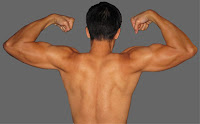There is something to be said about mastering the pull-up and chin-up. It is incredibly empowering to be able to pull one's bodyweight. In the event of a possible inevitable zombie apocalypse, those who can leap over walls and pull themselves onto rooftops will have an obvious advantage. Even if you don't believe in zombies, I hope that by the end of this blog you will be inspired to incorporate these often underrated (and frequently avoided) exercises into your workouts.
Back in 2008 I read an article in Men's Health magazine declaring that if a man cannot perform a set of 8 pull-ups followed by a set of 8 chest dips, he has no business attempting any other upper-body exercises. While I appreciate its sentiment, I do not agree with the smug delivery. Pull-ups are not for everyone and I do not discount anyone who favors other types of exercises. As a martial arts practitioner, I find that pull-ups and chin-ups are ideal for upper-body conditioning. To maximize the contractions and range of motion, I perform these exercises from a dead hang and explode into the contraction, retracting my shoulders and bringing my chest to the bar as fast as I can. I then spend about 2-3 seconds focusing on the negative resistance as I return to the dead hang.
Performed with a pronated (overhand) grip at slightly wider than shoulder-width, pull-ups primarily target the fan-shaped latissimus dorsi muscle or "lats". These are great for developing a wider back which also creates the illusion of having a slimmer waist. The rhomboids, middle trapezius, teres major, and teres minor are among the synergists that assist in the pulling motion. The wider your grip, the more you isolate the latissimus dorsi. However, doing so also limits the range of motion and places additional strain on the rotator muscles. Those with trouble rotator cuffs may find a wider grip to be painful, so experiment with grip width to find your "sweet spot".
 Chin-ups or "chinning" is done with a supinated (underhand) grip that is slightly wider than shoulder-width. It integrates and recruits more muscle groups than the pull-up, making the exercises slightly easier to perform. The chin-up also targets the latissimus dorsi, but unlike the pull-up, there is considerably more recruitment of the rhomboids, teres major, levator scapulae, middle trapezius, and lower trapezius. Virtually every muscle in your upper back is engaged during a chin-up and developing these muscles will result in a thicker back and neck. The chin-up is also a great bicep exercise since it targets both the bicep brachii and brachialis.
Chin-ups or "chinning" is done with a supinated (underhand) grip that is slightly wider than shoulder-width. It integrates and recruits more muscle groups than the pull-up, making the exercises slightly easier to perform. The chin-up also targets the latissimus dorsi, but unlike the pull-up, there is considerably more recruitment of the rhomboids, teres major, levator scapulae, middle trapezius, and lower trapezius. Virtually every muscle in your upper back is engaged during a chin-up and developing these muscles will result in a thicker back and neck. The chin-up is also a great bicep exercise since it targets both the bicep brachii and brachialis.  To varying degrees both exercises will improve grip strength and forearm musculature, as well as develop the back, shoulders, and biceps. However, I was surprised to learn that that they are also amazing core exercises. This realization inspired me to develop my I.C. Abs Program. I have stated in a previous blog that a basic primary function of the core muscles is protecting the spine by stabilizing the midsection. During a pull-up or chin-up, there is a natural tendency for the legs to swing and the midsection to curl or bend at various angles, making it more difficult to complete the movement. The body will intuitively attempt to correct for these extraneous movements through tightening of the core muscles. This method of tightening is also referred to as an isometric contraction because the muscles are in a static position. A more comprehensive instructional blog on isometric core exercises is in the works that will include my workout routines. In the meantime, Menshealth.com has featured some great isometric core exercises that can be performed with a basic weight plate.
To varying degrees both exercises will improve grip strength and forearm musculature, as well as develop the back, shoulders, and biceps. However, I was surprised to learn that that they are also amazing core exercises. This realization inspired me to develop my I.C. Abs Program. I have stated in a previous blog that a basic primary function of the core muscles is protecting the spine by stabilizing the midsection. During a pull-up or chin-up, there is a natural tendency for the legs to swing and the midsection to curl or bend at various angles, making it more difficult to complete the movement. The body will intuitively attempt to correct for these extraneous movements through tightening of the core muscles. This method of tightening is also referred to as an isometric contraction because the muscles are in a static position. A more comprehensive instructional blog on isometric core exercises is in the works that will include my workout routines. In the meantime, Menshealth.com has featured some great isometric core exercises that can be performed with a basic weight plate. 



